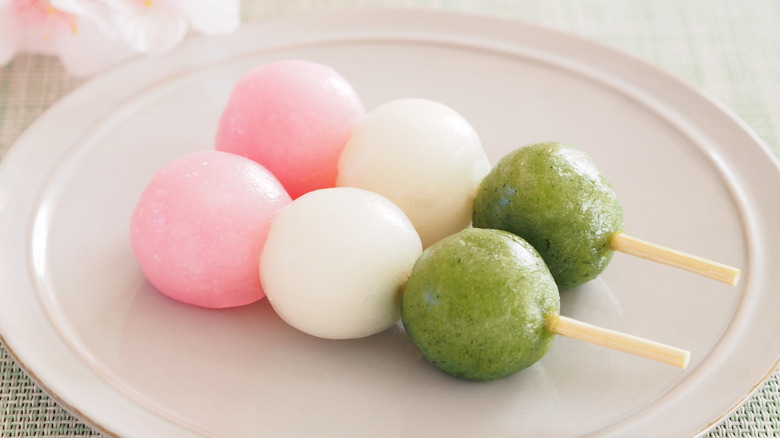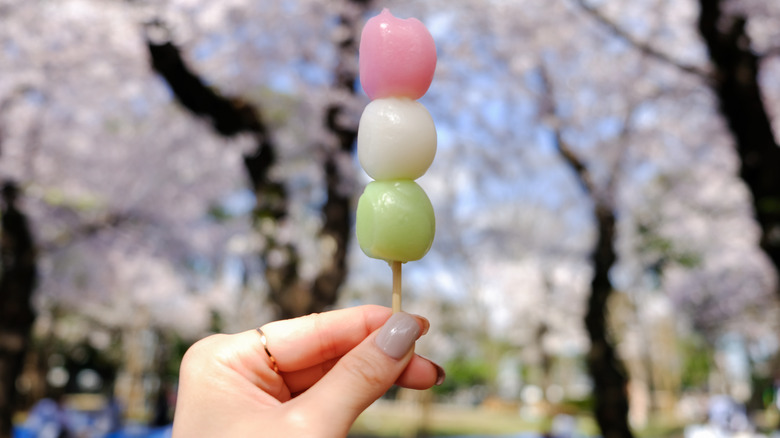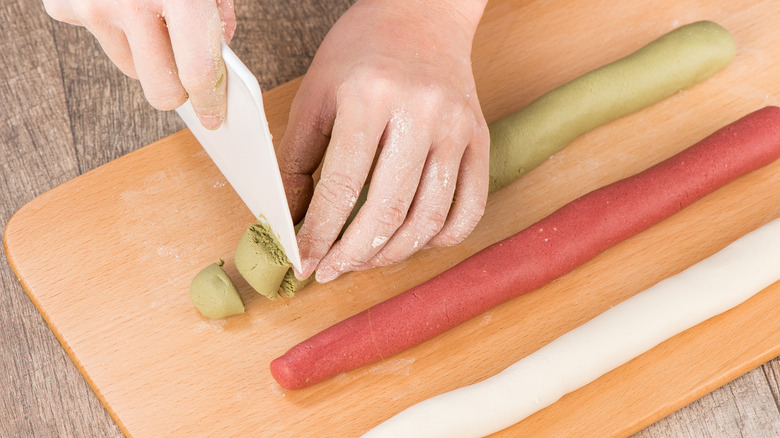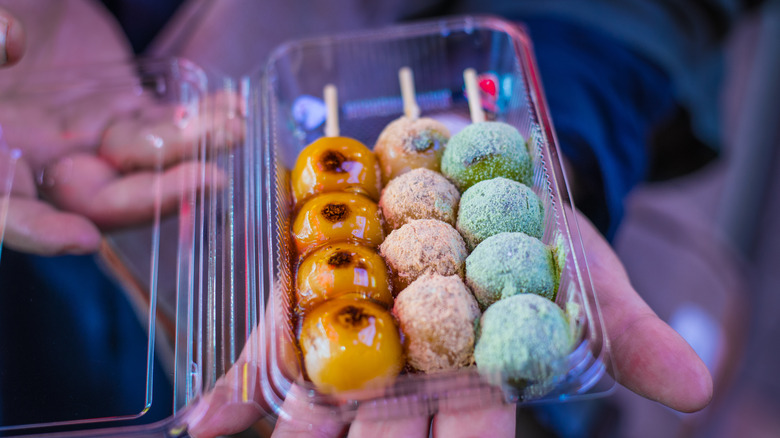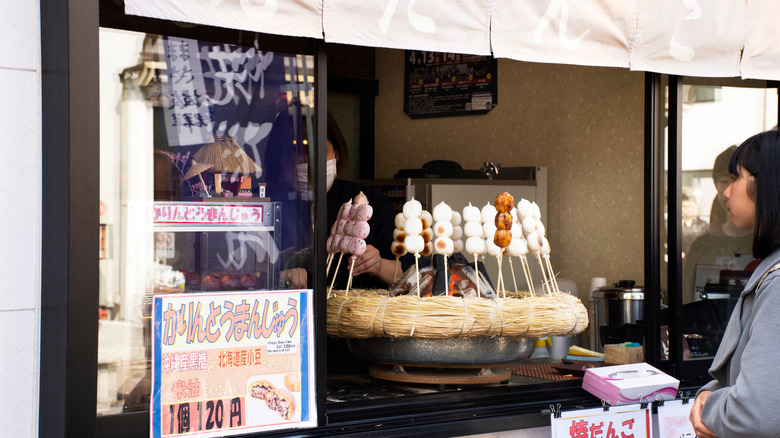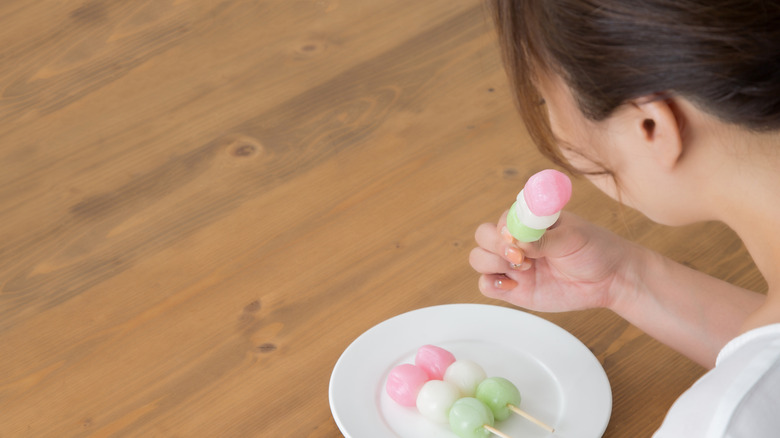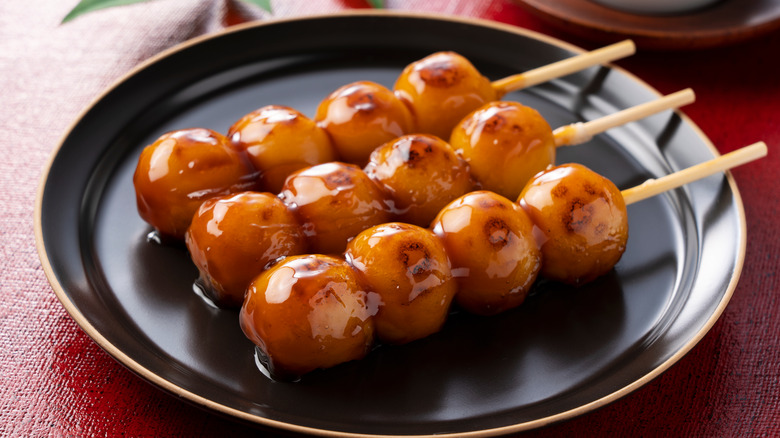Hanami Dango: The Tri-Colored Treat That Inspired An Emoji
Since the printing press, nothing has come close to impacting written language — until emojis that is, one communications librarian informed the Chicago Tribune. According to Hack Reactor, the use of emojis can be traced back to '90s chatrooms when : ) would indicate a smile. In 1999, a Japanese cell phone company took these basic communications a few steps further by releasing a set of images called emojis. The word, which is a fusion of Japanese phrases meaning "picture" and "letter," could be sent on pagers and cell phones. You can view the original designs at MoMA.
Today, there are more than 3,000 emojis, records Statista, and while anyone can suggest an emoji to be added to the ever-growing list, a group of employees from companies like Apple and Google must approve of the image. The skewered Japanese dumpling known as dango was added to the pictorial lineup in 2010 (via Emojipedia). While the colorful treat is fun to insert into conversation, there's meaning behind the playful design.
What is hanami dango?
Historical references to dango can be found as far back as the 10th century (via This Is Japan). Dango includes an entire group of dumplings, informs Okonomi Kitchen, but hanami dango, also known as sanshoku dango, is the specific name for the multicolored treats served on skewers and seen on emoji keyboards. Hanami, the Japanese ritual of springtime flower-watching, lends its name to these tasty rice dumplings, and there's meaning behind each color. Pink signifies cherry blossoms, white represents the snow of past seasons, and green is the color for grasses of the spring (via Taste Atlas).
Interpretations are many, however, and the three colors are also thought to represent blossoming cherry trees, white sake, and the flowering mugwort plant (per Kyoto Journal). Regardless of the interpretations assigned, this dessert is chewy, stretchy, and absolutely perfect for a relaxed picnic beneath a canopy of blossoming trees.
How is hanami dango made?
Dango is made from mixing equal parts sweet rice flour and regular rice flour — also known as shiratamako and joshinko – to build a stretchy dough (per Honest Food Talks). After boiled in water and left to cool, round dumplings are slid onto skewers and can be covered with glazes, pastes, or toppings (via MasterClass).
According to Sudachi Recipes, pink dango was traditionally colored by red shiso leaves and green dango with Japanese yomogi, but powdered strawberry or simple food coloring now more commonly yields the pink dumplings while matcha is used for green tints. To make softer dumplings, Simply Home Cooked recommends mixing dumpling dough with tofu instead of water and reminds the at-home dumpling maker to boil the rolled dumplings in a set order to preserve the brightness of the intended colors. Start with white, then pink, and save the green dumplings for last.
What does hanami dango taste like?
Since it's a dessert, count on hanami dango to be sweet. Freshly made dangos are warm, gummy, and soft. As the dumplings cool, the texture turns chewy. It's Foodtastic recommends heating up leftover dango in the microwave to soften before enjoying alongside a cup of tea.
Buttery Pan notes that the different varieties of hanami dango present unique flavors, from lightly fragrant to rich and buttery, and flavorings like chocolate or matcha can lend surprising complexity to an otherwise delicate recipe. Perfectly made dumplings aren't overpowering, but when green dango is colored by mugwort, you may notice an earthy, herbal taste (per The Japan Store). If you're looking for something more savory or are craving a sweeter treat to complete your meal, sample other varieties within the dango dumpling category or scroll through your emojis for inspiration. You'll find purin, a Japanese custard pudding, and kakigōri, a shaved ice dessert that can be flavored with syrup (via Nippon).
Where to buy hanami dango
Though hanami dango was traditionally made and served during Japan's cherry blossom season from March until May, the treat can now be found throughout the year (via Jasmine and Tea). In Japan, these colorful desserts are sold in convenience stores and supermarkets, and freshly made dumplings can be purchased from street stalls and festival stands (via Sakura).
If you're wanting to try making hanami dango at home, you may need to head to a specialty market or Asian food store to find the right kind of flour you'll need to make the dumpling dough (look for shiratamako glutinous rice flour and Joshinko non-glutinous rice flour). You can also purchase ingredients online to help you create a final product ready to share. Stored dumplings can last a few days when kept in the fridge and can be boiled again should the texture need a bit of plumping, advises Christie at Home.
Nutritional information about hanami dango
Hanami dango carries little nutritional value, according to Just One Cookbook. The colorful Japanese dessert is calorically dense and contains mostly carbohydrates, minimal protein, and a bit of fat, with trace amounts of potassium, calcium, and iron. Remember, dango is intended as a seasonal treat, and while the aesthetically-pleasing dish is ideal for food photography and updating Instagram feeds, Aspire Fitness Walnut warns that these dumplings contain sugar that could derail intended health goals.
Unless you're making hanami dango of your own, you can't be sure whether the green dumplings are tinted from food coloring, a powdered tea, or a herb. We recommend that since the skewer was intended for springtime enjoyment, consider sampling a stick of hanami dango with a health-boosting cup of green tea – under a flourishing cherry blossom tree, of course — and taking pictures to last until the next time you can sample this delicacy. Or, you can just send an emoji.
Other varieties of hanami dango
Because the ingredients used to color hanami dango can vary, the taste can be affected. For instance, Japan Taste admitted to trying dumplings in different areas, and the flavors couldn't be compared. One shop may use food coloring, another may use strawberry or raspberry powder, and sometimes, dumplings are scented with vanilla, tea, or salted cherry blossoms.
Of course, depending on what ingredients you can find, the green dumplings' flavor can be derived from yomogi grass or green tea powder (via Japanese Cooking 101). Apart from the tri-colored hanami dango variety, you can sample other dumplings in the dango family. Dango can be coated in sweet soy glaze (mitarashi dango) or red bean paste (anko dango). Smaller rice dumplings, called shiratama dango, are found in traditional desserts like anmitsu or kakigori. Goma dango is a deep fried version covered in sesame seeds and filled with red bean paste and the tsukimi dango pyramid is made up of 15 dumplings to honor autumn's full moon (via Sudachi Recipes). You may have to get creative to express some of these through emojis, though — at least until newer designs are approved.
